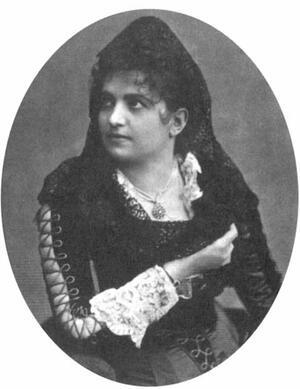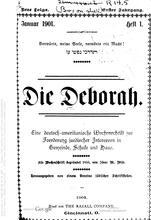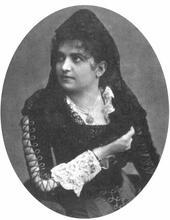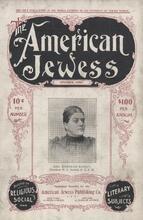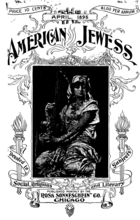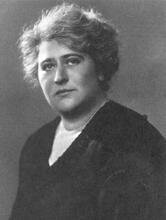The American Jewess
An ardent Zionist and advocate for an expanded role for women in the synagogue and religious community, Rosa Sonneschein founded and edited The American Jewess, which gave her a forum for those views.
Institution: The Jacob Rader Marcus Center of the American Jewish Archives, Cincinnati, OH, www.americanjewisharchives.org and the State Historical Society, MO
Published between 1895 and 1899, The American Jewess was the first independent English-language magazine published by and for Jewish women in the United States. Founded by Rosa Sonneschein, the magazine emerged from the network of activism created by late nineteenth-century middle-class Jewish clubwomen, particularly those from the National Council Of Jewish Women (NCJW). At its height, The American Jewess reached twenty-nine thousand subscribers. It discussed issues of fundamental importance to middle-class Jewish women, featuring columns, short fiction, biographical sketches, and news of and commentary on the NCJW and other Jewish female philanthropic efforts. Reflecting the ambivalence of the American Jewish community, The American Jewess featured articles both opposed to and in favor of greater political rights for women.
The American Jewess, published from April 1895 to August 1899, was the first independent English-language magazine published by and for Jewish women in the United States. Founded and edited by writer, journalist and clubwoman Rosa Sonneschein, the magazine emerged from the network of activism created by late nineteenth-century middle-class Jewish clubwomen, particularly those from the National Council Of Jewish Women (NCJW). The American Jewess also contributed to the NCJW by acting as a public forum promoting and supporting its activities and ideals.
Founding The American Jewess
Sonneschein, a clubwoman and writer active in Jewish and general women’s associations in St. Louis, first asserted the need for a magazine that would connect American Jewish women across the country in a speech at the May 1893 Press Congress, held during the World’s Columbian Exposition in Chicago. During a decade in which Jewish women’s associations, especially synagogue sisterhoods, multiplied rapidly, Sonneschein’s enthusiasm was particularly apt. In September 1893, also during the exposition, several prominent Jewish clubwomen, led by Hannah Greenebaum Solomon, held the Jewish Women’s Congress, bringing together participants from across the United States to discuss literature, philanthropy, and Judaism. Sonneschein likely garnered moral and financial support for The American Jewess from among these women and, in turn, lent her support to the NCJW, the organization they created.
In April 1895, Sonneschein began publishing The American Jewess from offices in Chicago. In 1896, Lucien Bonheur, well connected in New York financial and Jewish philanthropic circles, became Sonneschein’s business partner and the business manager for the magazine. Bonheur opened New York offices and worked to bring in new sources of advertising and patronage, and thus improve the magazine’s finances. Probably due partially to Bonheur’s efforts and partially to the growing membership of the NCJW, the magazine’s circulation reached the high figure of twenty-nine thousand subscribers.
Content of The American Jewess
Throughout its run, The American Jewess, in appealing to its intended audience of middle-class Jewish clubwomen, offered features both common to mainstream women’s magazines and specifically geared to Jewish women. Short fiction and columns on popular medicine, music and art, household management and fashion appeared in nearly every issue along with news of and commentary on the NCJW and other Jewish female philanthropic and social reform efforts, biographical sketches of prominent Jewish club and professional women, and articles by well-known rabbis and Jewish community leaders.
In its articles and editorials, The American Jewess discussed issues of fundamental concern to members of the NCJW and other middle-class Jewish women’s groups. American Jewess writers argued for expanded roles for women in the synagogue and Jewish community. They promoted, most often in a limited way, both the benefits of women’s education—particularly religious education—and the propriety of (some) women’s work outside the home. Reflecting the ambivalence of the Jewish community, The American Jewess featured articles both in favor of and opposed to greater political rights for women. Some argued for suffrage in the same vein as they argued for a greater role in the synagogue—as extending women’s moral guidance to the public sphere, where it was needed. More writers, however, including Sonneschein, believed that for American women—for middle-class women, in any case—suffrage was unnecessary. The gains that women had made through their club work and social positions convinced them that emancipation was a fact, not an unmet goal, except perhaps, some argued, in the religious sphere, where work remained to be done.
Relationship to the NCJW
In addition to these kinds of articles, The American Jewess explicitly allied itself with the work of the NCJW. Within the first months of publication, Rosa Sonneschein declared a natural affinity between the NCJW and The American Jewess and, as “a woman to women,” offered her magazine’s aid to the organization’s work. Several times, she proposed to turn the magazine into the NCJW’s official publication, a move that the organization’s leaders never accepted. Still, Sonneschein continued to demonstrate support for the organization by publishing progress reports from NCJW national leaders, minutes from local sections and papers originally read before various NCJW meetings, and by reporting and editorializing on important NCJW events and prospective directions for the organization.
Like the NCJW, The American Jewess conveyed the middle-class belief in an essentially domestic vocation for American Jewish women, which included the transmission of Jewish tradition to their families in order to ensure group survival in modern America. As well, within the terms of this vocation, The American Jewess vigorously advocated the enlarged role for women in the Jewish community for which Jewish clubwomen in the 1890s worked.
Discord between Sonneschein and the NCJW
Although Sonneschein expressed enthusiasm for the NCJW’s success, because the magazine did retain independence from the organization, she also did not hesitate to make The American Jewess a forum for her critiques of it. She commended the NCJW for its philanthropic works but argued that it had the potential to fulfill a needed service to the American Jewish community by pursuing a religious mission. To this end, The American Jewess praised the NCJW’s religious education work and called for more emphasis on Jewish observance. In the wake of the NCJW 1896 convention, at which NCJW president Hannah Solomon retained her position over the objections of more traditionally oriented members who argued that her observance of a Sunday Sabbath made her unfit to preside over a Jewish organization, Sonneschein increasingly criticized the NCJW in the pages of The American Jewess. Though she supported Solomon’s presidency, Sonneschein nevertheless deplored what she perceived as Solomon’s devaluing of the traditional (Saturday) Sabbath, viewing it as symptomatic of religious division and inconsistency within the NCJW.
In 1896, Sonneschein also proposed that the NCJW take up the cause of Zionism as a means to gain members among the mass of immigrant Jewish women and thus become a truly representative national organization. That the NCJW did not pursue either a religious mission or Zionism, thus seemingly rejecting Sonneschein’s recommendations, further fueled her criticism. This growing discord between Sonneschein and NCJW members likely contributed to the folding of The American Jewess.
Demise of The American Jewess
Despite the gains in advertising and patronage that resulted from Bonheur’s stint as business manager, financial difficulties prompted Sonneschein to seek more help for The American Jewess. In 1898, new managers took control over the magazine’s publication, though Sonneschein remained as editor. To the disappointment of the management, subscription support for the magazine declined, so much so that it had to fold in August 1899. In her angry valedictory editorial, Rosa Sonneschein blamed the magazine’s demise on its former subscribers, who, she believed, had become ashamed of receiving a Jewish magazine such as The American Jewess at home.
As of 2004, the entire collection of The American Jewess became available on the Internet. Through a venture of the Jewish Women’s Archives (JWA), in a combined effort with the Library of Congress, the libraries of Brandeis University and Hebrew Union College-the Jewish Institute of Religion, and the University of Michigan Digital Library Project, the entire original text and images of the magazine can be accessed and searched online at JWA’s website hosted by the University of Michigan
The American Jewess (1895–1899)
Berrol, Selma. “Class or Ethnicity: The Americanized German Jewish Woman and Her Middle Class Sisters in 1895.” Jewish Social Studies 47 (1985): 21–32
Goldman, Karla. Beyond the Synagogue Gallery. Cambridge, Massachusetts: Harvard University Press, 2000
Ibid. “Beyond the Gallery: The Place of Women in the Development of American Judaism.” Ph.D. diss., Harvard University, 1993.
Kuzmack, Linda Gordon. Woman’s Cause: The Jewish Woman’s Movement in England and the United States, 1881–1933. Columbis, Ohio: Ohio State University Press, 1990
Lichtenstein, Diane. Writing Their Nations: The Tradition of Nineteenth-Century American Jewish Women Writers. Bloomington, Indiana: Indiana University Press, 1992
Loth, David. “The American Jewess.” Midstream 31 (1985): 43–46.
Porter, Jack Nusan. “Rosa Sonnenschein [sic] and The American Jewess: The First Independent English Language Jewish Women’s Journal in the United States.” American Jewish History 67 (September 1978): 57–63,
Porter, Jack Nusen. “Rosa Sonneschein and The American Jewess Revisited: New Historical Information on an Early American Zionist and Jewish Feminist.” American Jewish Archives 32 (1980): 125–131.
Rogow, Faith. Gone to Another Meeting: The National Council of Jewish Women, 1893–1993. Tuscaloosa, Alabama: University of Alabama Press, 1993.
Sochen, June. Consecrate Every Day: The Public Lives of Jewish American Women, 1880–1980. New York: SUNY Press, 1981.
Sonneschein, Rosa. “The American Jewess.” The American Jewess 6 (February 1898): 205–208.
Sonneschein, Rosa. “The National Council of Jewish Women and Our Dream of Nationality.” The American Jewess 4 (October 1896): 28–32.

